by Bryan & Heather
Odd as it may seem to those accustomed to tales of a distant, arid frontier far to the West, the modern state of Alabama lies along what was the United States’ original zone of pioneer settlement on the far side of the Appalachians that separated the former English colonies from their indigenous neighbors in the interior. As such, the region is littered with pieces of frontier history, from now-abandoned towns like the first state capital of Cahawba to the sites of numerous clashes between encroaching Europeans and resisting Native Americans. This year, we decided to take a day to tour some of the latter, visiting two sites from the 1813-14 Creek War that catapulted its victorious American general, Andrew Jackson, to national fame.
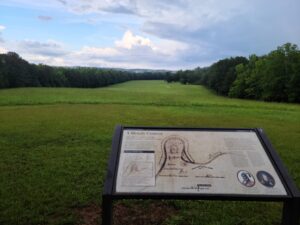
We began our trip with a visit to Horseshoe Bend National Military Park eighty miles southeast of Birmingham. Commemorating its namesake final battle of the Creek War, Horseshoe Bend encompasses the bend in the Tallapoosa River where militant anti-settler Red Stick Muscogee (Creek) warriors and their families had taken shelter in
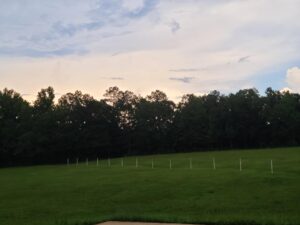
the temporary town of Tohopeka. In March of 1814, Andrew Jackson and his combined force of Tennessee militia, US Regulars, and allied Cherokee warriors surrounded the town. As the Regulars and their artillery squared off against the defensive log barricade the Muscogees had erected across the neck of the peninsula, Jackson’s native allies deployed along the far back of the river to cut off any escape. After a fierce afternoon of fighting, Tohopeka had been destroyed and over 800 Red Sticks were dead–the bloodiest single battle for Native Americans in American history.
We weren’t quite sure what to expect as we pulled up to the NPS Visitor Center that rainy July 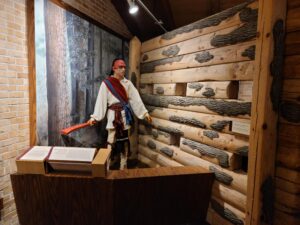 afternoon. The combination of a war of expansion, the presence of Andrew Jackson, and our location in the South could well have meant we were in for some chauvinistic history that ignored the darker side of our nation’s treatment of its
afternoon. The combination of a war of expansion, the presence of Andrew Jackson, and our location in the South could well have meant we were in for some chauvinistic history that ignored the darker side of our nation’s treatment of its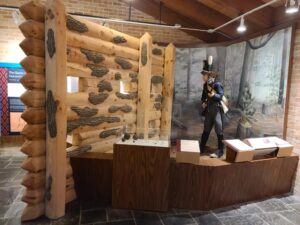 original inhabitants. To our pleasant surprise, however, the truth could not have been more different. While initial interpretation was likely in that vein, increasing cooperation and consultation with the Muscogee Nation in Oklahoma and local Poarch Band Creeks since the 1960s has culminated in respectful, historically responsible interpretation of the indigenous history of the region in general and the course of the Creek War in particular. While no serious efforts to reconstruct Tohopeka or the log barricade exist (likely due to budgetary constraints for a small, out of the way site), the
original inhabitants. To our pleasant surprise, however, the truth could not have been more different. While initial interpretation was likely in that vein, increasing cooperation and consultation with the Muscogee Nation in Oklahoma and local Poarch Band Creeks since the 1960s has culminated in respectful, historically responsible interpretation of the indigenous history of the region in general and the course of the Creek War in particular. While no serious efforts to reconstruct Tohopeka or the log barricade exist (likely due to budgetary constraints for a small, out of the way site), the
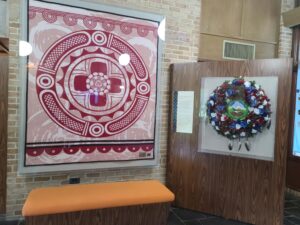
visitor center itself was very nice, and a driving tour was available via phone. We couldn’t help but feel that the park was in many ways a model of how to share Native American with the public.
Only two things at the park gave us pause. The first was a failure to tie the conflict into the larger, ongoing War of 1812, despite mentioning how Jackson went on from Horseshoe Bend to defend New Orleans the next year. We couldn’t help but notice elements of the provincialization of local history that Bryan wrote about concerning the Fort Pitt museum last year, resulting in the mystifying choice not to impress visitors with the importance of the history being interpreted. More intriguing, however, was the second. As we entered the visitor center, we observed two bronze plaques facing each other across the entryway, each a memorial to those that fell on one side of the conflict battle, Red Stick warriors on the left and US soldiers and their native allies on the right. We didn’t quite know what to make of this somber “both sides” memorialization. On the one hand, we were encouraged that the struggle of Native Americans against American imperialism was being acknowledged as worthy of respect and remembrance. Yet
impress visitors with the importance of the history being interpreted. More intriguing, however, was the second. As we entered the visitor center, we observed two bronze plaques facing each other across the entryway, each a memorial to those that fell on one side of the conflict battle, Red Stick warriors on the left and US soldiers and their native allies on the right. We didn’t quite know what to make of this somber “both sides” memorialization. On the one hand, we were encouraged that the struggle of Native Americans against American imperialism was being acknowledged as worthy of respect and remembrance. Yet 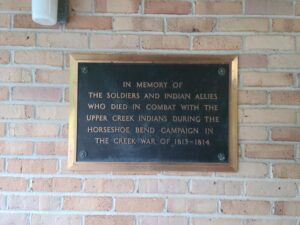 on the other, we couldn’t really get behind the honoring of both the white soldiers who killed close to a thousand Native Americans and burned their town and members of a militant movement who had slaughtered white and native civilians–including women and children-at Fort Mims a year earlier, instigating Jackson’s punitive expedition. While on some levels understandable, especially given the involvement of the Muscogee Nation with the modern park, we couldn’t help but feel that the better approach would have been not “both sides,” but, in Heather’s words, “no sides.”
on the other, we couldn’t really get behind the honoring of both the white soldiers who killed close to a thousand Native Americans and burned their town and members of a militant movement who had slaughtered white and native civilians–including women and children-at Fort Mims a year earlier, instigating Jackson’s punitive expedition. While on some levels understandable, especially given the involvement of the Muscogee Nation with the modern park, we couldn’t help but feel that the better approach would have been not “both sides,” but, in Heather’s words, “no sides.”

After wrapping up our driving tour of Horseshoe Bend, we then struck north towards the town of Alexandria and the site of one Jackon’s early victories at the Muscogee town of Tallushatchee. Heather’s discovery of this site is what had initially fueled our plans for the day, particularly the eyebrow-raising fact that Jackson had “adopted” a surviving Muscogee babe into his family in the aftermath of the battle. When we

finally tracked down the small, fenced off “battlefield park” by the side of a back road, we were in for a wildly different experience than the one we had left. Two stone monuments stood side by side on a small patch of (admittedly well-maintained) grass. The older, placed by the Daughters of the American Revolution on the battle’s centenary in 1913, simply commemorated Jackson’s victory. The second, newer (2000) and taller monument was dedicated entirely to Lincoya, Jackson’s adopted Muscogee son. In what could only be described as convenient oversimplification, its two faces described how Jackson benevolently cared for the child after the surviving Muscogee women “were planning to kill the infant, as was their custom” in the wake of his mother’s death, “loving” and “educating” him as his own.
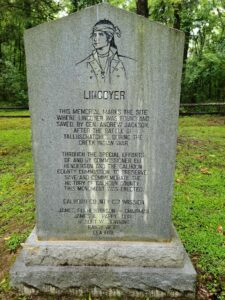
Here at Tallushatchee, then, was the approach to Alabama history that we had been worried we might find at Horseshoe Bend. Neither monument made any attempt to explain why the Red Sticks were fighting, or that this was a village that Jackson had attacked, or that white settlers were consistently violating the terms of agreements Native Americans had negotiated with the Federal government that should have made their lands inviolable. Instead, Calhoun County Commission celebrated the problematic adoption of a child by his mother’s killer not because Lincoya was about to be murdered but, as the National Park Service explains in Lincoya’s online biography, because the other surviving women were too seriously injured to take care of him. It is also unclear just how loving that relationship was; Jackson might have
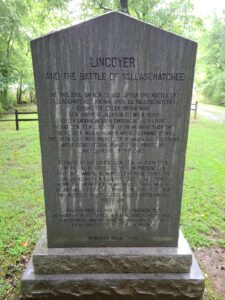
had intentions to send Lincoya to West Point, but he died at 16 from tuberculosis and the two other Muscogee children that Jackson adopted around this time were explicitly described as being “petts” for his white children–companions somewhere between the status of chattel slave and free white citizen. To top it all off, there is no known contemporary likeness or depiction of Lincoya, begging the question of whose engraved portrait crowns the monument!
As we got back on the road headed for home at the end of a long day of battlefielding, we couldn;t help but reflect on how commemoration and memorialization plays such a central and complicated role in how society remembers its history. The popularity and prominence of Horseshoe Bend relative to Tallushatchee was certainly encouraging, but even that park was not without its problems, and seeing such a benignly racist monument from as recently as 2000 was unsettling, if ultimately unsurprising. We can only hope that in future years, the long arc of interpretation continues to bend towards the kind of responsible, respectful history we saw along the quiet banks of the Tallapoosa and not turn back towards other regrettable celebrations of imperialism and blithe racial superiority that continue to haunt our nation.
